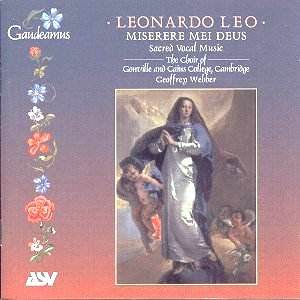
|
Leonardo LEO (1694-1744)
Miserere mei Deus, Judica me Deus, Eripe me, Domine, Hoc corpus, quod pro vobis tradetur, Praebe Virgo*, Reminiscere miserationum tuarum, Tribulationis cordis mei, Intellege clamorem meum, Kyrie (from Mass in C), Christus factus est pro nobis, Heu nos miseros Domenico ZIPOLI (1688-1728) Verse (1) and Canzona in G minor, All'offertorio, Verse (1) and Canzona in E minor Recorded in the Chapels of Emmanuel College and Queens' College, Cambridge, 13 and 17-19/4/2000 |
Although the music of Leonardo Leo has never really obtained widespread currency, he has not lacked friends. As the note-writer points out, Wagner described the "Miserere" as "built like a mighty cathedral", and a reading of the same piece inspired Verdi to plan the creation of a schola cantorum. In England our own C. V. Stanford published an edition of "Dixit Dominus" (a piece not included here) thus provoking at least some awareness of Leo's music in British choirs.
Leo was of the Neapolitan school, a school which, at the transition between Renaissance and Baroque, tended to employ a particularly severe religious tone, in painting as in music, with sombre colours and a very traditional approach (basically looking back to the past rather than moving into the new Baroque world) which however did not exclude considerable exploration of chromatic harmonies.
We can hear all this at once in the "Miserere", but as to Wagner's "mighty cathedral of sound", I wonder what type of performance he heard. Geoffrey Webber's very carefully prepared performance seems to aim at bringing out the old-fashioned aspects of the piece. Each section is beautifully, expressively shaped, and often in total contrast to the sections on either side of it. In other words, a typically Renaissance succession of miniatures, with the implicit assumption on Webber's part that an overall design is not part of the composer's agenda.
He may be right, of course, and we will never know exactly what Wagner heard in Naples in 1880. But not all that long ago Italian choirs were still giving Renaissance music with a slancio which Webber, maybe with good reason, would probably consider more suitable for Leoncavallo than for Leo. Since this went hand in hand with operatic vibrato in no small measure the results were fairly frightful. However, some modern Italian groups have been studying Renaissance vocal technique seriously and are learning to create a suitable sound without losing their innate Italian-ness.
Still, I raise the matter more as a talking-point than as an out-and-out criticism, and do not deny that the performances are excellently done from their own point of view. Particularly impressive is the last piece, "Heu nos miseros", with its rich nine-part texture, though this piece may not actually be by Leo.
A fair amount of the music here is in similar vein to the "Miserere", but we have several hints, and one absolute proof, that there was a very different side to him. He was mostly an operatic composer, after all, and opera in Naples was much more forward-looking than ecclesiastical music, thanks to the work of Alessandro Scarlatti (Leo's senior by 34 years, but you wouldn't think so from comparing their music). "Praebe Virgo" is an extended virtuoso piece for soprano and organ, with a rhythmic propulsion and a general cut to its which make it seem almost a pre-echo of Mozart's "Exsultate, Jubilate". If this is typical of what Leo could do when writing for solo voices, perhaps his operas should be investigated. It is also a very difficult piece. Angharad Gruffyd Jones has a rich-toned voice and for a lot of the time she finds the right ease of production, but she is still at that unsettled stage where her high notes come better or worse according to the note that has preceded them, or the vowel she has to sing. I can't quite relax and enjoy it on account of the times when she trips off the tightrope. I think this was not ready for recording and I hope she will continue studying before plunging into a wide range of repertoire, or we risk having the Gwyneth Jones tragedy all over again. It seems a little odd that she should have been brought into the project when, as we hear later in "Intellege clamorem meum", at least one of the choir's own number, Abigail Boreham, could perhaps have done it better.
This latter piece is another with Baroque leanings, and so is the Kyrie. So too, I had always believed, were the Zipoli pieces which are interspersed in the programme on account of the lack of any extant solo organ works by Leo himself. But according to Webber, who provides the very informative notes, their style is "retrospective, with verses and canzonas in the same basic manner that Frescobaldi had adopted a century earlier". And that is how they are played here, spelt out very didactically, note for note (except, perhaps, for "All'offertorio"), as if in fear of allowing the emergence of the propulsive rhythmic swing typical of the Italian Baroque. Unlike the Leo, I have some hands-on experience here and can only say that Italian organists are rather fond of Zipoli precisely because he was moving towards that sense of linearity and rhythmic excitement which we expect of the Baroque, and tend to play him as proto-Vivaldi rather than as leftovers from Frescobaldi. The music responds easily to that treatment and quite frankly sounds so much better that I find it difficult to imagine that the composer intended something different.
Admirers of Italian music of this period will be glad to have this finely recorded disc of performances which, as I say, are excellent given their point of view. I'm not sure how recommendable it is to those listeners who lack the back-up knowledge to judge it.
Christopher Howell